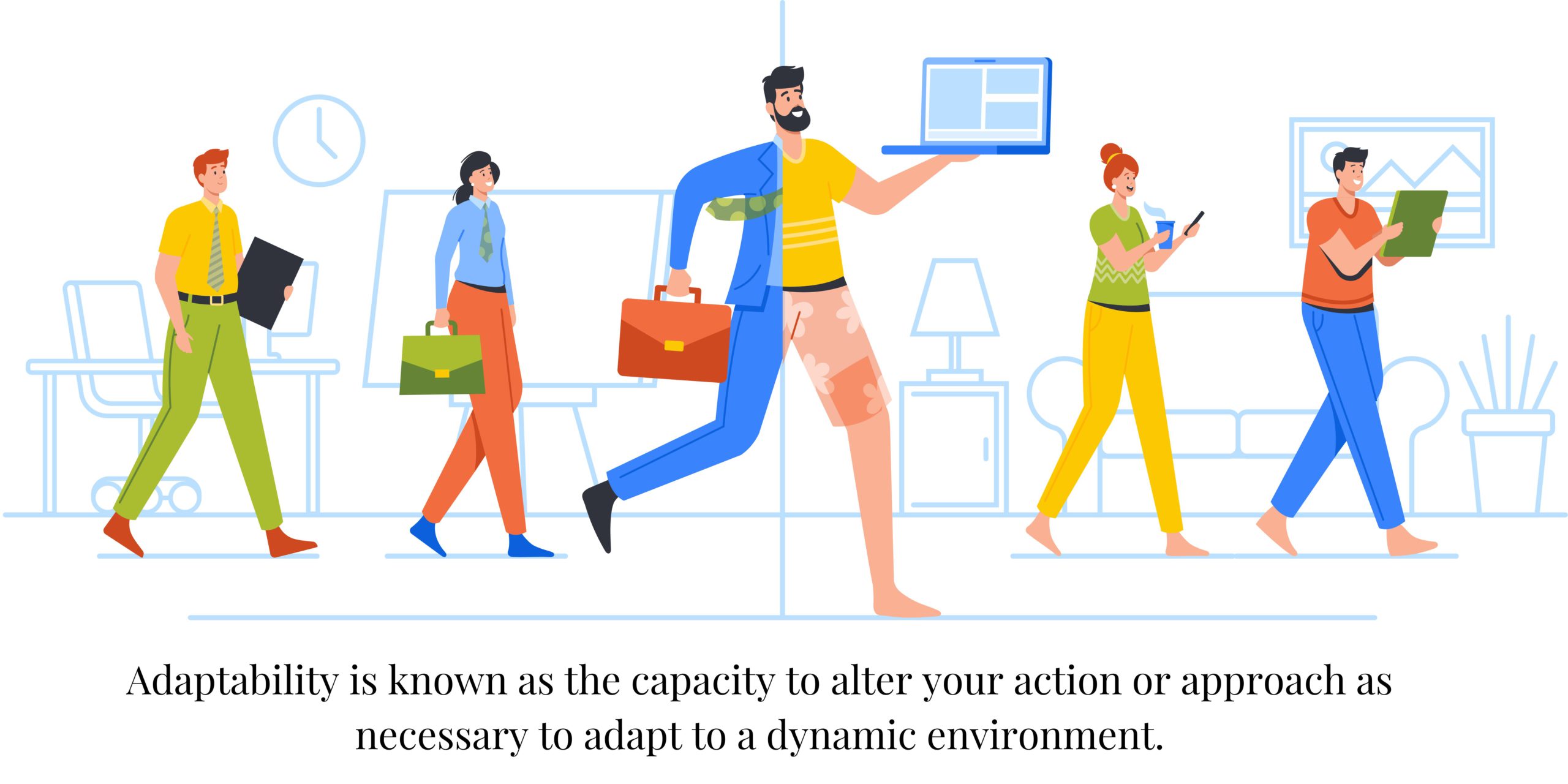Adaptability in the Workplace: Defining and Improving This Key Skill
Abonnez-vous à la newsletter
Regardless of your profession or length of employment, adaptability is a valuable talent to possess. It’s no surprise that one of the five most important abilities that businesses want in candidates is adaptability. The necessity to be adaptable and flexible in light of changing circumstances is the most important lesson the past few years have taught us. It is a crucial component of professional development, stress management, and resilience.
We are the only species capable of anticipating the future and imagining situations. This is referred to as “prospecting” by psychologists like Roy F. Baumeister and Martin Seligman, among others.
We refer to this ability in practice as being future-focused. Future-focused leaders will be crucial as we recover from the whiff of recession and rethink the future of employment. They typically exhibit traits that others can learn from, such as being more successful, optimistic, and far less agitated than their peers.
Regardless of what issue arises, you must be capable of handling it well and advancing. A crucial life and career skill is adaptability.
You’ll be a more compelling applicant for jobs and a more effective professional overall if you can adjust to new settings and work methods. If you are flexible and eager to learn new things and undertake new tasks, you definitely have adaptability skills. Moreover, improving your flexibility might also entail enhancing additional soft skills, such as interpersonal and communication skills.
Charles Darwin spoke famously as to how the civilization that survives is neither the smartest nor the one with the greatest physical prowess. It is the one that can adjust to change the best.
What is adaptability?
Adam Grant stresses the value of having an open mind in his best-selling book, Think Again. A key component of becoming more adaptable is the capacity to rethink situations and act accordingly.

Adaptability is known as the capacity to alter your action or approach as necessary to adapt to a dynamic environment. In today’s dynamic workplace, it is essential for success. A change in expectations or priorities can be easily adjusted by those who are flexible.
The opposite of inflexibility is an adaptation, which is the capacity to change and adjust. People that are rigid or inflexible struggle to adapt to novel circumstances. Employees with these qualities may come across as disengaged or uncommitted.
They might be reluctant to take risks, worry that they won’t succeed, push back against adjustments that might improve their working lives, and refuse to grow from their failures. They frequently struggle to hear and take feedback into account.
Even in leaders, a lack of adaptation can be disastrous. Leaders must be able to analyze their team’s processes and recognize any modifications that may be required for success in the future.
What are the qualities of adaptability?
People and organizations who possess adaptability abilities are better able to thrive in times of transition or when confronted with novel problems. During challenging circumstances, such as a pandemic, the capacity for adaptation is essential for both managers and their staff.
When the workplace environment changes quickly, flexible individuals and teams may adjust without suffering productivity or quality losses.
Social flexibility, behavioral flexibility, and cognitive flexibility are the three different categories of adaptation skills. The first two pertain to changing how you think and interact with other people, while the third is about changing how you act.
You may have noticed that problem-solving and adaptation skills are not the same. Finding the best answer to an issue can be one of your problem-solving skills; however, adaptability is just the capacity to adjust to fluctuations in demands and priorities, which are frequently beyond your control. However, stronger and more original problem-solving often results from an adaptive attitude.
Consider interpersonal abilities like active listening and development mindset along with cognitive abilities such as critical thinking when you’re considering adaptability. Soft skill sets like teamwork, communication, and leadership are also a part of adaptability.
Examples of adaptation abilities include the capacity to deal with change and satisfy the requirements of new initiatives. Examples of adaptation skills and how they might be used or utilized in the job are provided below:
Leadership qualities
Adaptive leaders will modify their strategy when dealing with a team member or employee based on the person’s abilities or working preferences. This is a crucial ability that makes sure everyone is respected and acknowledged for who they are as individuals. They can contribute effectively to a range of tasks or teams.
Persistence in the face of setbacks
We frequently have to abandon existing plans and think of fresh ones when difficulties arise. Flexible employees can accomplish this without becoming frustrated or confused by the adjustment. They are adaptable and receptive to new concepts.
Rarely do those who adapt successfully experience pressure to give up. Every task is thrilling, and being committed to their work involves persevering even when times are challenging. They may also maintain their composure and help their team members maintain their focus when things get tough.
Versatile in communication
Depending on the circumstance, a skilled communicator will use a different approach when speaking with diverse stakeholders. They can alter their strategy rather than continue with one. It can ease tension, aid learning, and spur change if necessary.
New tech
Each of us has a favorite method of working, and routines are simple to form. We can adopt new technology and learn new skills when we are adaptive. This can improve productivity by streamlining processes.
Taking criticism with a growth mindset
A person with a growth mindset thinks they can constantly gain more and get better, while a person with a closed mind thinks certain traits, like intelligence, are fixed and cannot be changed. Because they are more ready to face new problems to develop and grow from them, individuals exhibiting growth mindsets are adaptable.
Rigid people may take criticism personally. High levels of flexibility make people receptive to new ideas. They possess a growth attitude and are always questioning their preconceived notions and methods.
Resourcefulness
The result is frequently obvious, but the way to get out there is not. Seeing as there may not be enough funding or staffing, the “conventional” way of doing business may not be feasible or productive. Adaptability can be useful in this situation. A flexible individual is likely to find fresh tools and methods that their less flexible coworkers haven’t thought about.
Why leadership flexibility is crucial
We are aware that to manage a team successfully, leaders must be competent and willing to adapt. What does this look like in reality, though? For leaders, simply promising to behave differently or implement changes is insufficient. They need to act as well. The flexibility and willingness of leaders must be used as instruments. They may be able to succeed as a result at work and elsewhere.
3 strategies to create flexible leaders
To guarantee that both they and their employees can be adaptable in the midst of change, leaders must be adaptable in the workplace. Here are three suggestions for assisting your leaders in becoming more flexible:
- Possess a sharp vision
Leaders need to be aware of their objectives and have a plan for getting there. But they also need to maintain an open mind to fresh options. Managers should always be aware of their motivations. There ought to be several ways to achieve success, not just one, and every choice should be in line with the ultimate objective.
- Promote inventiveness
Innovation is indeed a step on the path of coming up with fresh answers to persistent issues. Leaders should foster conditions that encourage creative thinking at every organizational level. Only in an atmosphere that encourages and celebrates creativity can it flourish.
- Increase safety
Taking chances is a necessary part of adaptability. Nevertheless, persons in leadership positions could face pressure to provide particular outcomes. Making mistakes could feel risky as a result. Favor daring action over flawless outcomes.
Guidelines for fostering flexibility in teams

You can incorporate adaptability-building into your group’s culture. You may discuss it with your colleagues as a philosophy and method of working. Here are some strategies for encouraging future-oriented thinking and agility in your team:
- Keep an open mind
When you’re established in your habits, it’s difficult to avoid becoming closed off. However, having an open mind may enable you to get insight from others, discover fresh viewpoints, and make wiser decisions.
- Accept the procedure
Recognize that there is always room for development. Don’t give up since learning is something that never ends. As James Clear highlights in Atomic Habits, small steps taken in the right direction can lead to big changes.
- Give yourself some leeway
Don’t be afraid to make mistakes. Be prepared for circumstances to go wrong. These errors offer priceless possibilities for growth and agility training.
- Promote a climate of trust and openness
Inform others about the squad’s and the company’s developments. In addition, give staff who are having trouble with jobs or projects regular feedback and direction. Make it a habit to receive feedback, and invite others to do the same for you.
- Encourage your group.
Regardless if they are unrelated to their job role, give employees a chance to develop new skills. Take them on trips to different departments, or enroll them in online classes on topics that will assist them in acquiring new talents. Project management and public speaking are a couple of these.
Conclusion

The ability to adjust to change is an essential skill in today’s business. Our capacity for adaptation, however, can make it easier for us to deal with unpredictability both at work and outside of it. Although you can’t predict the future, you can be confident in your capacity to deal with whatever arises.